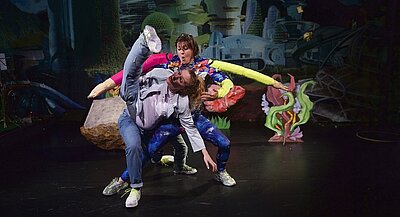Orbital Inclination

In April, choreographer Cécile Bally, together with Cathy Walsh, will present the children’s piece "Über Überüberübermorgen" ("The Day after the Day after Tomorrow", from 2022) at the Feld Theater für junges Publikum. For tanzraumberlin magazine, she will be writing about her work with Science Fiction as a political practice and choreographic tool to imagine a hypothetically imagined future based on social relationships and collective fears and hopes.
Text: Cécile Bally
Choreographer, performer and stage designer
As much as I like to read and watch Hard Sci-Fi and space operas, as much as I like to travel through the stars and meet alien species, the Science Fiction I like creating on stage is one based on social relations and locality. Science Fiction as a tool to think of a dreamed future built on collective fear and hope, a catalyst of social change. Science Fiction uses the future as a blank canvas on which to project concerns that occupy society right now […] for SF writers, the mere idea of ‘things to come’ is licence to re-imagine, re-configure, and re-interrogate the present.[1]
My journey with Science Fiction has been a collective one, responding to a desire to facilitate the writing of a performance as a political practice.
Allowing yourself to dream local, to imagine a future that includes your own reality. Here lies the challenge. During the year that led to our performance The Flood, Emma Tricard and I hosted a series of SF writing Workshops in Germany, Belgium, France and Chile. We had these questions: how can a SF book be written collectively? How can a story, addressing local issues and local hopes, travel through different countries and continents and be continued by groups that experience a daily life in completely different ways? How can we create a common story that does not flatten the specificities? A story related to the fear of floods in Kortrijk; electrified by months of massive demonstrations and the hope of having a new constitution in Santiago; informed by daily-life in a psychiatric facility in Aix-en-Provence, etc.
Based on those encounters, we co-wrote a novel with Clay A.D. that we then adapted into a performance.
The party was in full swing already. There was hardcore cumbia playing and the space was crowded, my senses suddenly overwhelmed by trying to take everything in. Some people had oxygen masks on. They likely belonged to the military and the state official class, though most of them had dressed down to try to fit in. In the masks they could breathe perfectly well, but came here to bottom feed and feel their neighbors running out of air. The physical suffering excited them.[1]
The fictions written during The Flood workshops were often cataclysmic. When we decided to create a SF children’s piece with Cathy Walsh, our premise was to propose a future that children would look forward to. One source of inspiration was encounters with school kids about their understanding of the future. Über Überüberübermorgen is a Solarpunk work reflecting on the notion of time and linearity. The Solarpunk movement started in South America and it envisions an optimistic future with a sustainable mix of nature and Jugaad (i.e. DIY) innovations. As DIY magic is a technique I craft in each of my works, I was immediately taken with Solarpunk. In the show, we created a sandwich tree, extra limbs that grow on plants and an app to translate from elefoctopus to human language.
When magic becomes real
Looking at my artistic journey over the last 10 years: being a modern vampire trying to act rationally in a world that doesn’t believe in them anymore, populating a supermarket where the products are trying to trick you, bumming around a futuristic banlieue as teenagers, fighting the inhibiting power of synthetic fries and implanted AI in the flooded city of K, time traveling.
I transitioned from the Fantastique, where inexplicable supernatural events appear in realistic narrative, to Science Fiction. The more I set my characters in the future, the more they found their reality believable. As if previously, they had been placed in a magical world without understanding how they ended up there and now I’m placing them in a world that is logical for them, where magic is accepted and has become technology.
What hasn’t changed is my working method. I still start with the creation of the world: the scenography that brings the characters to life and induces the movement and the narration. A patchwork of personas whose dances stem from their environment, constantly falling from one vivid dream to another.
As my next work is about video games, I am transferring this journey to the digital realm, migrating from a material to a projected set. I used to read SF to dream, now I read it to escape the thoughts of the present.
Über Überüberübermorgen
(The Day after the Day after Tomorrow)
For children 5 +
by Cécile Bally and Cathy Walsh
18.–21.4.2024, FELD Theater für junges Publikum
[1] Clay A.D., The Flood (2021) Murdered Ones Press
[1] Ghalayini B., Palestine +100 (2019) Comma Press